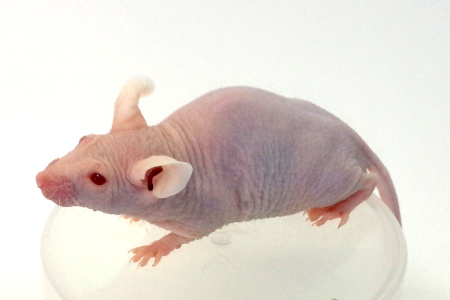| HR-1 (Hairless mice) | |
 |
|||
| Proper name | Hos:HR-1 | ||
| Description | Homozygous mutants (Hrhr/Hrhr) show normal development of the first hair coat (first hair cycle). Starting at 2 weeks of age, they lose their hair coat rapidly and completely due to an abnormal second hair cycle [1, 2]. At weaning (~3 weeks of age), they are completely hairless [3]. | ||
| Appearance | albino, without hair, unaffected | ||
| Genotype | Hrhr/Hrhr an insertion mutation in intron 6 of mutant Hr genes [3] |
||
| Reseach | * dermatology, wound healing model, safety and efficacy testing * scratching response of hairless mice with atopic dermatitis-like dry skin → HR-AD diet * inflammatory acne mouse model [4] * photochemical skin micronucleus test [5] * photochemical genotoxicity [5] * In vivo bioluminescence imaging [6] |
||
| Development | The hairless mutation (Hrhr) was found at Sandra Biological Supply in New York City in 1968. It was brought to Temple University and crossed to CBA mice. These mice were named Skh:HR. We received non-alvino Skh:HR mice and generated homozygous albino animals that are segregating for the hairless phenotype. We named these mice Hos:HR-1. | ||
| Attention | Breeding is prohibited. | ||
| References | [1] Brooke, H.C. 1926. Hairless mice. J. Hered. 17, 173–174. |
||
